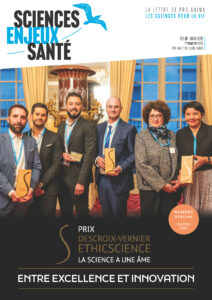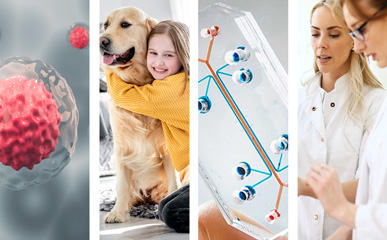
EFPIA Statement on AI, EU Health Data Hub, ONTOX Hackathon winners, Artificial ovary first blueprint and more
News on non-animal methods
APRIL 29 - MAY 03, 2024NEWS, REPORTS & POSITION STATEMENTS
1. AI Act : EFPIA Statement on the use of AI in the medicinal product lifecycle
EFPIA believes in the potential of applying AI to deliver benefit for patients, life-science companies and society. It will have an ever more critical role in the research, development and manufacturing of medicinal products, meaning we can discover, develop and deliver new, safer, more effective treatments to patients faster than ever before.
The development and authorisation of safe and effective medicines is already governed by a well-established regulatory framework, which includes laws, guidance documents and other policies. EFPIA supports the European Medicines Regulatory Network’s (EMRN) considered approach to AI, which builds on existing methods, good research practices, and requirements applied to other drug development tools (such as traditional statistical methods and approaches including model informed drug development). EFPIA made five considerations that are critical for the use and governance of AI across the medicine development lifecycle.
2. Making European Health Data Space EHDS a reality
Now that the European Health Data Space (EHDS) regulation has been adopted by the European Parliament on April 24, 2024, the HealthData@EU Pilot project is continuing its work to make the secondary use of health data part of the EHDS a reality.
Consisting of a consortium of 17 organizations led by the Health Data Hub and co-funded by the European Commission’s EU4Health program, the HealthData@EU Pilot project’s mission is to build a test version of the European infrastructure for the secondary use of health data. This part of the regulation will facilitate research, innovation and public policy development.
INTERVIEWS, NOMINATIONS & AWARDS
3. The FC3R’s “Digital approaches” awards
The French center for the 3Rs (FC3R) attributed 4 awards to innovative research projects to Replace the use of animals in research : from neuroscience and cancer research to virtual twins, personalized medicine and eco-toxicology.
These projects illustrate the scientific community’s commitment to pushing back the frontiers of knowledge while adopting ethical and innovative approaches to research.
Discover the 4 winners of the FC3R’s “Digital approaches”
4. ONTOX Hackathon winners
Last week, the ONTOX Hackathon was pivotal in demonstrating how AI can transform safety and risk assessment to the benefit of EU citizens and the environment, driving significant advancements without animal testing.
This event was the first milestone towards creating a community of practice for AI in toxicology. The Hackathon outcomes are planned for publication in the ATLA journal.
Discover the ONTOX Hackathon winners
TOOLS, PLATFORMS, CALLS
5. Emulate Organ-chips : To model the holistic journey of solid tumor cell therapy
Cell therapy trafficking remains a critical rate-limiting step of cell therapy efficacy for solid tumors. With the CAR T workflow for Emulate Organ-Chips, researchers can model the holistic journey of CAR T‑cell therapy from blood vessel to target — including CAR T cell vascular administration, tumor inflammation-specific endothelial cell attachment and migration, and antigen-specific killing — in a vascularized cancer cell line model.
This novel and flexible workflow allows for a more complete, human-relevant assessment of cell therapy recruitment and efficacy than alternatives, providing researchers with the ability to discover and evaluate CAR engineering and co-therapeutic approaches to improve cell therapy migration and efficacy against solid tumor targets.
INDUSTRY, BIOTECH & PARTNERSHIPS
6. CN Bio raises $21 million USD in first close of Series B investment round
CN Bio, a leading provider of single- and multi-organ microphysiological systems, recently announced it has raised a $21 million investment in the first close of its Series B fundraising round. The global OOC market’s CAGR (Compound Annual Growth Rate) is estimated at 30.94%. With the latest fundraising and recent legislative changes, such as the US FDA Modernization Act 2.0, CN Bio is well-positioned to continue its global expansion to meet the evolving needs of customers worldwide in key markets including toxicology, drug pharmacology and metabolic diseases.
Dr Paul Brooks, CEO, CN Bio, said : “We are seeing pivotal growth across our industry, whereby drug developers are increasingly recognizing the potential of OOC technology to augment, supplement and optimize their workflows.”
7. Xaira Therapeutics launches with over $1 Billion to enhance drug R&D using AI
Xaira Therapeutics, an integrated biotechnology company driving advances in artificial intelligence (AI), has emerged as one of the most significantly funded new entrants in the biotech sector, supported by a consortium of venture capitalists and eminent scientists.
Marc Tessier-Lavigne, a former president of Stanford University and chief scientific officer at Genentech, has been appointed as CEO of Xaira.
The startup is not only focusing on AI-driven drug discovery but also aims to revolutionize the entire drug development pipeline, from discovering new biology and designing molecules to running clinical trials. This holistic approach intends to address the inefficiencies of an industry plagued by low success rates.
8. Pfizer and the Austrian research institute : To lead to new AI models for drug discovery
A three-year collaboration between Pfizer and the Research Center for Molecular Medicine of the Austrian Academy of Sciences (CeMM) has resulted in a new AI-driven drug discovery method that could make it faster and easier to identify small molecules with therapeutic potential.
In an article published April 25 in Science, CeMM researchers described how they created and scaled an AI and machine learning platform that measures how hundreds of small molecules bind to thousands of different human proteins, generating a catalog that can be used as the starting point for new drug development.
9. Moderna and OpenAI : Accelerate the development of life-saving treatments
Moderna has been at the intersection of science, technology, and health for more than 10 years. Moderna has adopted a people-centric, technology-forward approach, constantly testing new technology and innovation that can increase human capacity and clinical performance. The company has partnered with OpenAI since early 2023. Now, ChatGPT Enterprise is evolving how Moderna operates across each function.
“We believe very profoundly at Moderna that ChatGPT and what OpenAI is doing is going to change the world. We’re looking at every business process — from legal, to research, to manufacturing, to commercial — and thinking about how to redesign them with AI” — Stéphane Bancel, CEO of Moderna.
SCIENTIFIC DISCOVERIES & PROTOCOLS
10. Wiring principles in the human cortex
Understanding properties and connectivity of neurons in the human brain cortex is critical for understanding the mechanisms supporting cognitive functions. Most of our current knowledge of the cortical synaptic structure is derived from rodent studies.
Peng et al. analyzed multineuron patch-clamp recordings obtained from human cortical brain slices to determine the principles governing synaptic connectivity and compared the results with rodent cortical activity. Unlike in rodents, connectivity in the human cortex is heterogeneous and exhibits a directed and mostly acyclic graph topology. Using these principles in neural network models increased dimensionality and improved performance in functionally relevant tasks, suggesting that these properties of cortical connectivity in humans facilitate high-order computation.
11. The first blueprint for building an artificial ovary
Research engineers at the University of Michigan (U‑M, USA) used spatial transcriptomics in tissue samples to provide an insight into the structure of the human ovary, creating an atlas with cell-level resolution. Not only does this atlas give us a greater understanding of the ovary, but it also serves as a potential blueprint for building artificial ovaries in cases where ovaries have been exposed to toxic medical treatments or are exhibiting dysregulated hormone production.
U‑M’s work is part of the Human Cell Atlas project, which seeks to create “maps of all the different cells, their molecular characteristics and where they are located, to understand how the human body works and what goes wrong in disease.” Shikanov, Li and U‑M collaborators such as Sue Hammoud, are mapping other parts of the female reproductive system, including the uterus, and fallopian tubes.
Read the press release of the University of Michigan
Read the study in Science Advances
12. A pan-cancer analysis of the microbiome in metastatic cancer
Microbial communities are resident to multiple niches of the human body and are important modulators of the host immune system and responses to anticancer therapies. To investigate the presence and relevance of the microbiome in metastases, researchers from the Netherlands Cancer Institute integrated mapping and assembly-based metagenomics, genomics, transcriptomics, and clinical data of 4,160 metastatic tumor biopsies.
The study identified organ-specific tropisms of microbes, enrichments of anaerobic bacteria in hypoxic tumors, associations between microbial diversity and tumor-infiltrating neutrophils and more. Together, they generated a pan-cancer resource of the metastatic tumor microbiome that may contribute to advancing treatment strategies.
UPCOMING WEBINARS, WORKSHOPS, SYMPOSIA
Organ-on-a-Chip Workshop : A LUMC & Fluigent Collaborative Innovation Event — May, 6th Leiden (The Netherland)


